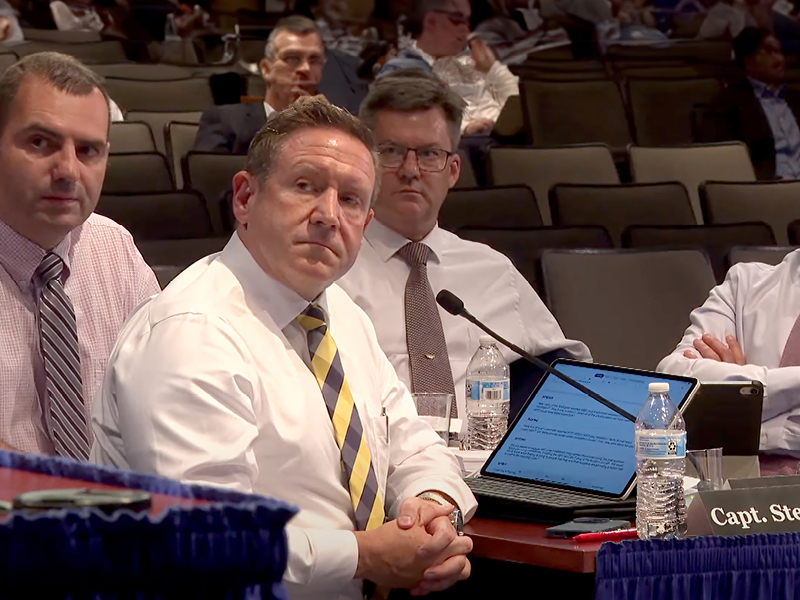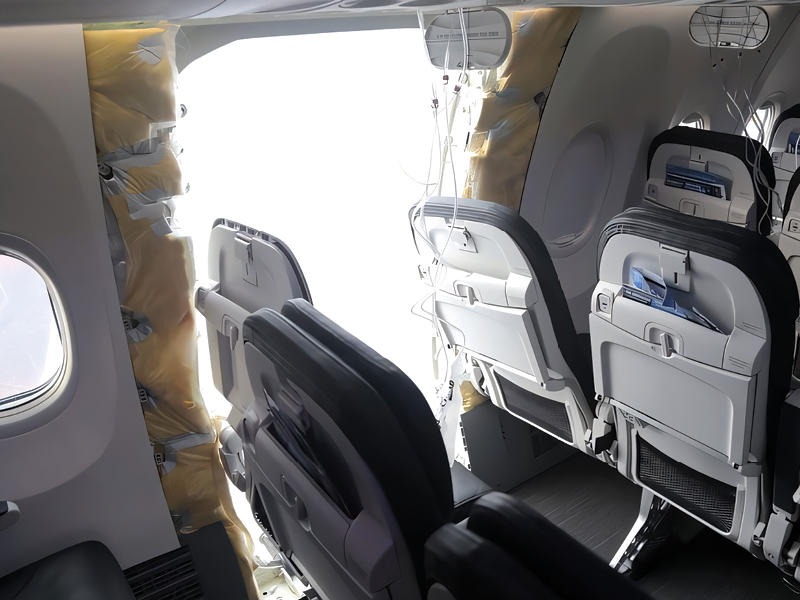NTSB Hears Witness Testimony Regarding Alaska Airlines Flight 1282 Door Plug Accident
ALPA Participates as Party to the Hearing
By Gavin Francis, Senior Aviation Writer

Capt. Steve Jangelis (Delta), ALPA’s Aviation Safety Group chair, participates in witness questioning during the NTSB hearing.
The NTSB convened an investigative hearing on August 6–7 to examine the Jan. 5, 2024, in-flight blowout of a left mid-exit door (MED) plug on Alaska Airlines Flight 1282. The accident, which involved a B-737-9 MAX, occurred shortly after takeoff from Portland International Airport. The sudden loss of the MED resulted in rapid cabin depressurization, forcing the flight crew to declare an emergency and return to the airport for an immediate landing. The two flightcrew members, four cabin crewmembers, and 171 passengers aboard disembarked safely at the gate, with only minor injuries reported among seven passengers and one flight attendant.
Recognizing ALPA’s critical role in providing subject-matter expertise on aviation safety, the Association was named a party to the hearing, which featured testimony from four witness panels composed of representatives from the FAA, Boeing, Spirit AeroSystems, and the International Association of Machinists. Each panel provided insight into different aspects of the accident, focusing on the manufacturing processes, quality control, and regulatory oversight that may have played a role in the failure of the MED plug.

The left mid-exit door plug blew out on Alaska Airlines Flight 1282 shortly after takeoff from Portland International Airport.
ALPA’s participation underscores the NTSB’s practice of involving stakeholders with specialized knowledge in the investigative process. Capt. Steve Jangelis (Delta), ALPA’s Air Safety Organization Aviation Safety Group chair, represented the Association at the hearing as the party spokesperson. His involvement was particularly significant in bringing attention to the human factors and operational aspects that contributed to the safe outcome of the flight.
Witnesses from Boeing and Spirit AeroSystems provided an overview of the B-737-9 MAX manufacturing and inspection processes, including the assembly and installation of critical components like the MED plug. The panel discussed how the MED was originally installed, and then later opened and closed again due to rivets that hadn’t been properly installed. The testimony highlighted potential lapses in the quality-control processes and the challenges in ensuring that every component meets the stringent safety standards required for commercial aviation.
Testimony was also given about broader safety practices, including the role of safety management systems (SMS) and quality management systems in preventing such accidents. The NTSB explored how these systems were implemented by Boeing and its suppliers and whether they were adequate in identifying and mitigating risks associated with the MED plug. Additionally, the panel examined the FAA’s oversight of these processes, questioning whether the regulatory framework and inspections were sufficient to catch potential issues before they could lead to a catastrophic failure.
When Jangelis asked how important it was to have two pilots on the flight deck to ensure the eventual outcome of the flight, Paul J. Wright, Boeing’s senior director for SMS, responded initially that he didn’t have enough information about the details of the investigation to have formed an opinion.
“But you would agree that the two pilots did a good job that day?” asked Jangelis.
“I think the flight crew and cabin crew performed flawlessly,” Wright concurred.
The question is significant because some aircraft manufacturers have recently explored the possibility of producing airliners that could be certified for single-pilot operations during cruise on long-haul flights. ALPA has aggressively opposed the idea, asserting that decreasing the required number of pilots on the flight deck is a significant threat to aviation safety.
Jangelis also asked questions about the “Speak Up” program, a confidential reporting system similar to the Aviation Safety Action Program, used by Boeing employees to raise concerns about product quality and safety without fear of retaliation. The program is designed to empower employees to report potential safety issues before they escalate into serious problems. By bringing this program to the forefront of discussion, ALPA sought to underscore the importance of fostering a culture of safety where concerns can be openly communicated and addressed.
Much of the testimony echoed statements made previously in witness interviews, information that will help the NTSB to determine the probable cause of the MED plug blowout and make recommendations to prevent similar accidents in the future. ALPA’s involvement, particularly its focus on operational safety and pilot expertise, will help to inform the NTSB’s findings and recommendations, which could lead to changes in manufacturing processes, maintenance protocols, and regulatory oversight.

